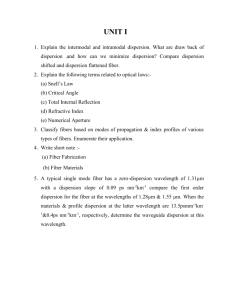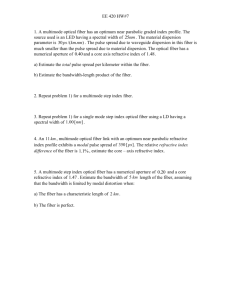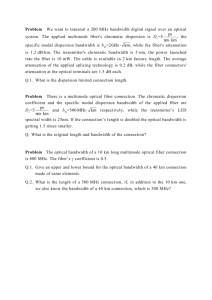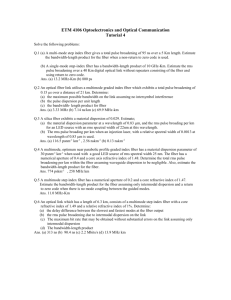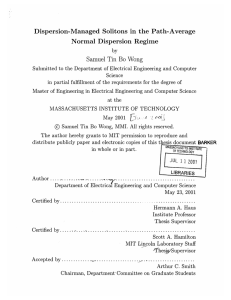Optical Fiber Communication Lecture 13
advertisement
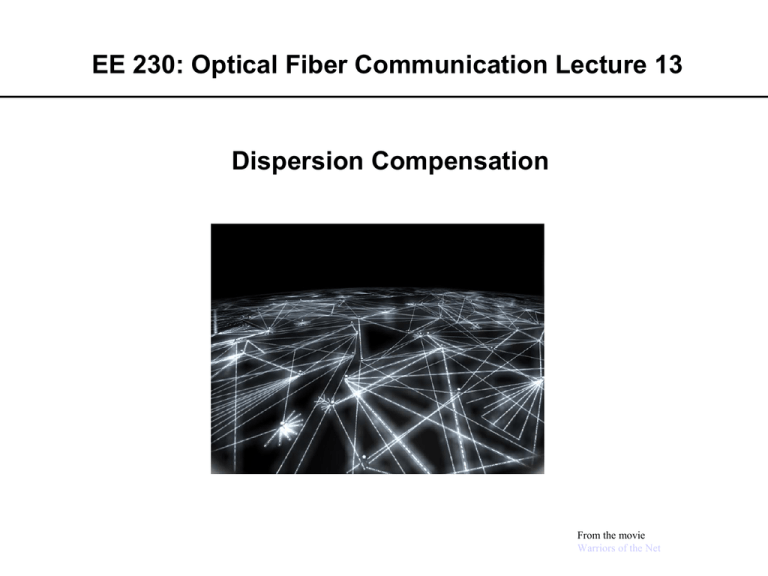
EE 230: Optical Fiber Communication Lecture 13 Dispersion Compensation From the movie Warriors of the Net Pulse Dispersion Definition of chirp The chirp C is defined by the change in frequency d due to the rate of change of the phase: d Ct d 2 dt is the initial 1/e duration of the pulse Spread of Gaussian Pulse 2 2 3 L C 2 L 2 L 2 2 1 1 C 4 3 2 02 2 02 2 02 0 2 2 Dispersion Power Penalty at different Bit Rates Degradation of a 40 Gb/s Signal Ideal Dispersion Compensation Device • • • • • • • • Large negative dispersion coefficient Low attenuation Minimal nonlinear contributions Wide bandwidth Corrects dispersion slope as well Minimal ripple Polarization independent Manufacturable Various Dispersion Compensation Techniques Propagation of Gaussian Pulses Input Pulse Output Pulse chirped and broadened 2<0 for standard single mode silica fiber and Ld ~ 1800 km at 2.5 Gb/s and ~115 km at 10 Gb/s Input Pulse Already Positively Chirped After some distance the chirp is removed and the pulse assumes its minimum possible width Upon further propagation the pulse will continue to broaden and acquire chirp. Optical Networks a Practical Perspective-Ramaswami and Sivarajan Spectral Shaping at the Transmitter Optical Fiber Telecommunications IIIA Compensation at Receiver • Adjust decision point on the fly based on previous few bits • Mathematically extrapolate signal back to what it presumably was at origin • These techniques can be used only if calculations can be done much faster than bit rate Dispersion Properties of Various Fibers Chromatic Dispersion Properties of Various Fibers Conventional Dispersion Compensating Fiber Fiber Optic Communications Technology- Mynbaev & Scheiner Dispersion Compensating Fiber Use of Dispersion Compensating Fiber Understanding Fiber Optics-Hecht Problem with Conventional Dispersion Shifted Fiber Importance of Slope Matching Link Distance Dependence on Slope Matching Higher order Mode DispersionProperties LaserComm High-Order-Mode Dispersion Compensation Device Compensation with Optical Filters 1 AL, t 2 i 2 A' 0, H exp 2 2 L it d Chirped fiber Bragg grating dispersion 2n D c where is the difference between Bragg wavelengths at ends of grating. For n=1.45 and =0.2 nm, D=4.8x107 ps/(km-nm) as compared to 18 for fiber Chirped Fiber Bragg Gratings Optical Networks A Practical Perspective-Ramaswami & Sivarajan Pulse Spreading due to Self Phase Modulation Four-wave Mixing Taylor Series expansion of β(ω) Through the cubic term: 0 1 where 2 d i i d i 2 2 3 6 3 ... Importance of Taylor Series terms Group velocity Vg, dispersion D, and dispersion slope S Vg 1 1 2c D 2 2 dD 2c 4c S 2 3 3 2 d 2 Four-Wave Mixing Phase-Matching Requirement Phase mismatch M needs to be small for FWM to occur significantly M 3 4 1 2 Spectral Inversion • Add pump signal whose wavelength is ideally at zero-dispersion point • Four-wave mixing generates phase conjugate signal at 2p-s • Phase conjugate undoes both GVD and SPM over second half of link • Filter out pump beam at end Mid-Span Spectral Inversion Optical Fiber Telecommunications IIIA Dispersion Managed Network Summary of Techniques • At transmitter: prechirping, coding • At receiver: signal analysis, decision point adjustment • Fiber: DCF, DSF, dual-mode fiber • Filters: Bragg gratings, Mach-Zehnders • Spectral inversion

